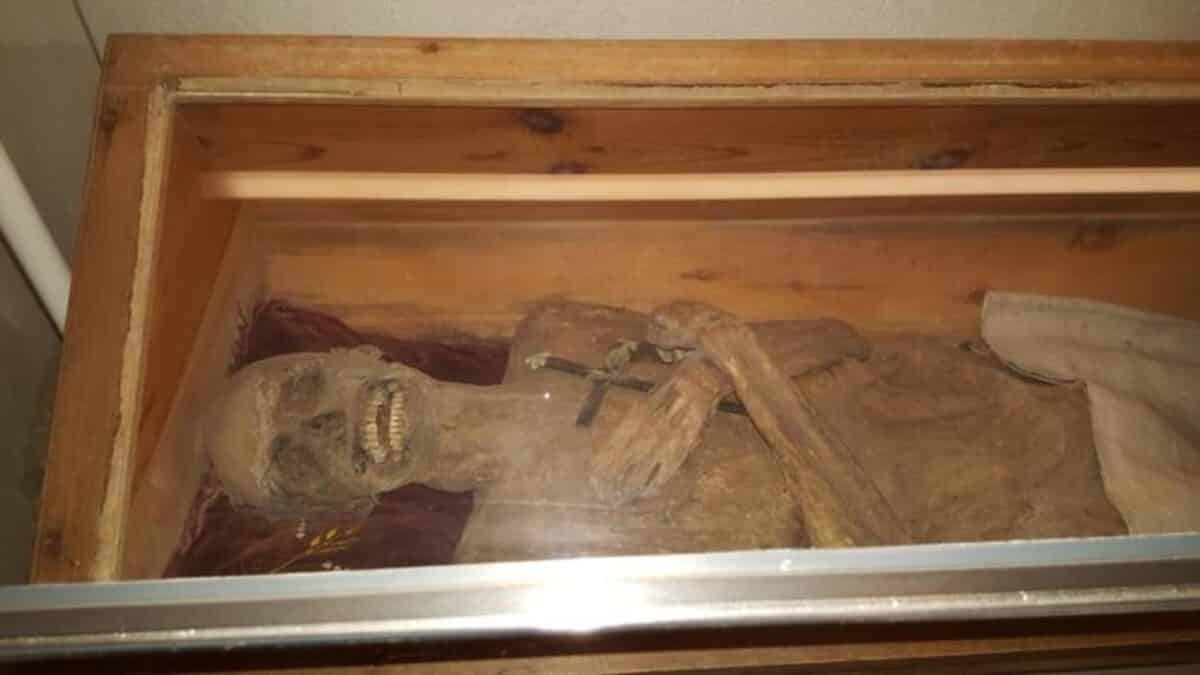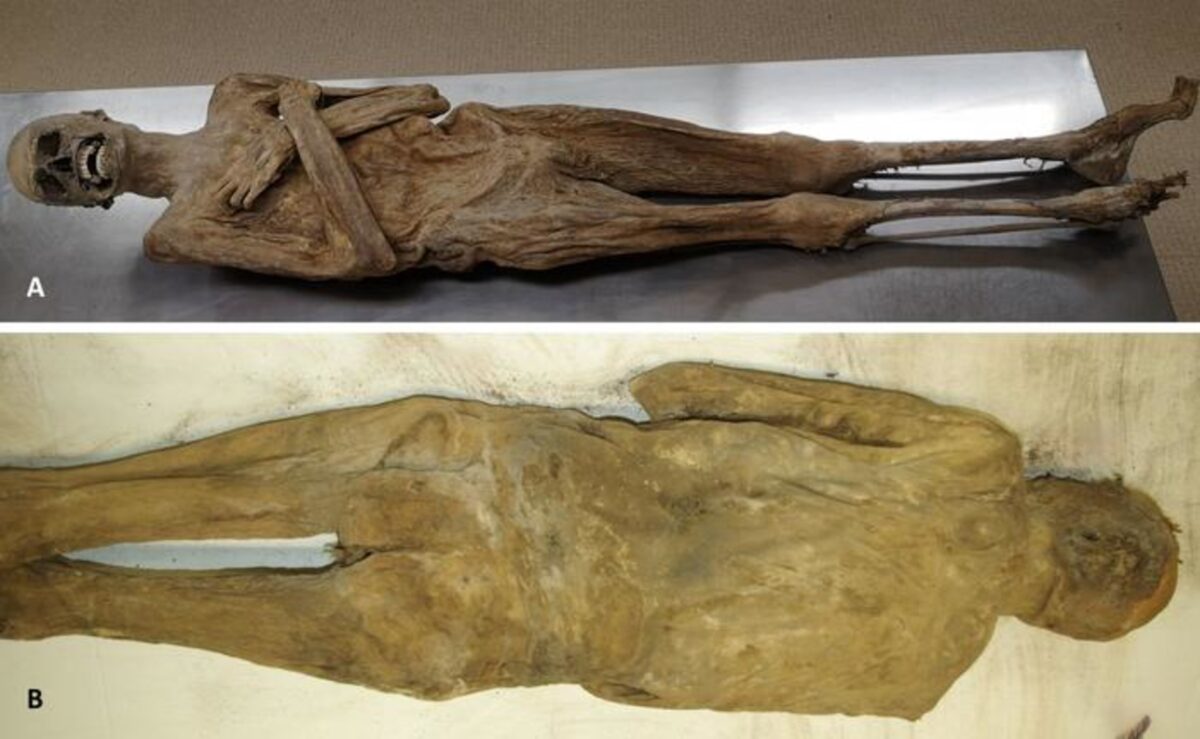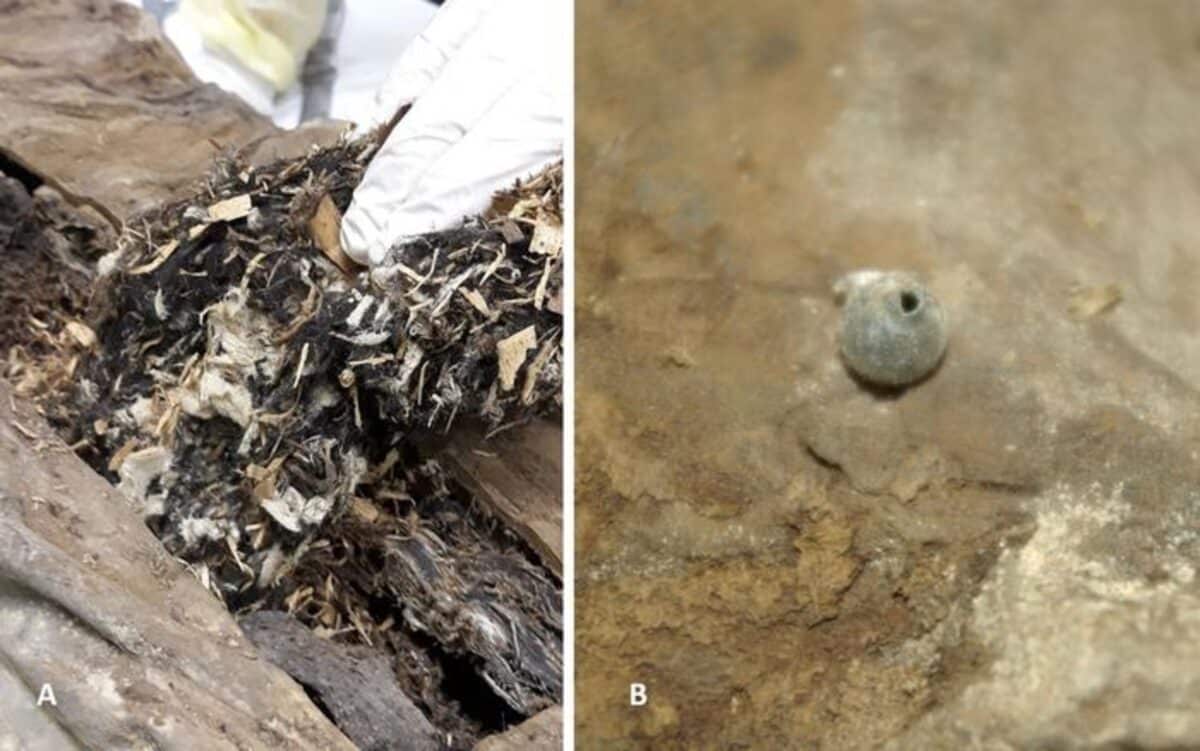
The mummy of the 'air-dried chaplain' in his coffin in the church crypt of St. Thomas am Blasenstein, Austria. (CREDIT: Andreas Nerlich)
In a nutshell
- The 18th-century mummy of Franz Xaver Sidler, dubbed the “Air-Dried Chaplain,” was preserved using a unique embalming technique that involved inserting wood chips, fabric, and zinc chloride through the rectum—a method never before documented in European mummification.
- Sidler likely died from pulmonary tuberculosis, with evidence of chronic lung damage and a fatal hemorrhage caused by the disease, marking a significant finding in the study of historical diseases and their effects on the body.
- Modern technologies like CT scans, stable isotope analysis, and toxicological tests revealed Sidler’s aristocratic background, diet, and the mystery behind his extraordinary preservation, providing a rare glimpse into 18th-century embalming practices and life.
MUNICH — The rectum isn’t typically associated with mummification techniques, but scientists have just discovered that’s exactly how an 18th-century Austrian priest became one of Europe’s best-preserved mummies. Dubbed the “air-dried chaplain,” this unusually well-preserved body wasn’t the result of divine intervention as locals believed, but rather an ingenious preservation method involving zinc, wood chips, and fabric stuffed through his rectum.
For years, locals in the small Austrian village of St. Thomas am Blasenstein speculated wildly about why the body remained so well-preserved. Theories ranged from radioactive radiation to special climatic conditions, with some even attributing miraculous properties to the corpse. But the real method turned out to be far more practical, and somewhat macabre.
Unusual Preservation Technique Discovered
The international study, published in Frontiers in Medicine, included a thorough investigation of the mummy, which had been kept in the church crypt of St. Thomas am Blasenstein. Their examination included a whole-body CT scan, radiocarbon dating, stable isotope analysis, and tissue sampling.
The mummy belongs to Franz Xaver Sidler von Rosenegg, a parish vicar who died in 1746 at age 37. While his extremities and face showed decay, his torso remained remarkably intact, a preservation pattern that initially confused researchers.

Andreas Nerlich)
The CT scan revealed that the abdominal cavity contained various foreign materials that weren’t visible from the outside, as both the ventral and dorsal body walls were completely intact. This finding suggested deliberate preservation rather than natural mummification.
When researchers performed a limited autopsy through a small incision in the back, they discovered the abdominal cavity packed with an assortment of materials: wood chips from fir and spruce trees, fragmented twigs, and numerous fabric pieces ranging from simple hemp to elaborate embroidered linen and even expensive silk.
Toxicological analysis revealed high concentrations of zinc and copper in the body tissues, along with traces of arsenic. Zinc chloride is a powerful drying agent with antimicrobial properties, suggesting it was deliberately used to preserve the body.
Since the body walls showed no signs of being opened, researchers concluded the materials must have been inserted through the rectum, which showed slight dilation consistent with post-mortem manipulation.
Life, Disease, and Death of an 18th-Century Clergyman

Andreas Nerlich)
Researchers also reconstructed Sidler’s life and cause of death. Stable isotope analysis of different tissues showed he enjoyed a high-quality diet rich in animal protein, typical of the aristocratic and monastic classes of his time.
CT scans and tissue analysis revealed Sidler suffered from chronic pulmonary tuberculosis. His lungs contained multiple calcifications typical of tuberculosis, as well as a cavity in the right lower lobe. The researchers believe he likely died from acute pulmonary hemorrhage caused by his tuberculosis eroding a blood vessel, a common cause of death in untreated tuberculosis cases.
Dental analysis showed he was probably a pipe smoker, based on characteristic wear patterns on his front teeth. He had some dental issues, including periodontal disease and calculus (tartar) buildup. The researchers also noted a slight hallux valgus deformity of his left big toe, suggesting he wore fashionably narrow shoes.
Radiocarbon dating placed the mummy between 1730 and 1780 CE, which aligns with historical records indicating Sidler died in 1746. The multiple lines of evidence confirmed the mummy’s identity as Franz Xaver Sidler von Rosenegg.
Lost Embalming Practices

Andreas Nerlich)
While ancient Egyptian mummification is well-documented, European embalming practices from the 18th century are less understood. Most historical embalming involved opening the cadaver through an incision in the abdominal wall.
The researchers found a few references to “tar-and-sawdust embalming” in 18th-century England, where carpenters who doubled as undertakers offered simple preservation methods. An Italian embalmer’s records mention a mixture of sawdust and zinc chloride, but no details on application methods.
“We have some written evidence that cadavers were ‘prepared’ for transport or elongated laying-out of the dead – although no report provides any precise description,” says study author Andreas Nerlich from Ludwig-Maximilians-Universität, in a statement. “Possibly, the vicar was planned for transportation to his home abbey, which might have failed for unknown reasons.”
The most likely scenario is that shortly after Sidler’s death, someone, perhaps concerned about contagion from his tuberculosis, performed this internal embalming through the rectum. The mixture of absorbent materials and zinc treatment effectively preserved the body, particularly the torso.

Andreas Nerlich)
One peculiar discovery was a small hollow glass sphere in the pelvic cavity that initially sparked rumors of poisoning. Analysis revealed it was merely a decorative glass bead, possibly from a rosary or ecclesiastical ornament that accidentally fell into the body during the embalming process.
This preservation technique might have been more common than we realize. Without modern CT scanning technology, such internal packing would be difficult to detect in other historical remains. Previous studies using only conventional X-rays, including one conducted on this same mummy in 2000, failed to detect the extensive packing material.
The “air-dried chaplain” gives us a rare glimpse into 18th-century improvised preservation techniques. While we’ll never know who packed Sidler’s body with zinc-treated materials, their handiwork survived nearly three centuries. This remarkably intact corpse remained a mystery until researchers finally looked where no one thought to check.
Paper Summary
Methodology
Researchers conducted a comprehensive investigation of the mummy known as the “air-dried chaplain” from St. Thomas am Blasenstein in Upper Austria. The study included macroscopic examination, whole-body CT scanning, focused autopsy through a paravertebral incision, radiocarbon dating, stable isotope analysis, histological examination of tissue samples, toxicological analysis, and material analysis of foreign substances found in the body. The team looked at bone measurements for age estimation, examined dental patterns, and analyzed tissue samples from various parts of the body to determine diet, potential cause of death, and preservation methods.
Results
The researchers identified the mummy as Franz Xaver Sidler von Rosenegg, a parish vicar who died in 1746 at age 37. Radiocarbon dating placed the death between 1730-1780 CE, with the highest probability between 1725-1815. The body showed excellent preservation of the torso but poorer preservation of the face and extremities. The abdominal cavity was filled with wood chips, twigs, and various fabrics including hemp, flax, cotton with embroidery, and silk, all inserted through the rectum. Toxicological analysis revealed high levels of zinc and copper, suggesting treatment with zinc chloride as a preservative. The individual showed signs of chronic pulmonary tuberculosis with characteristic calcifications and a cavity in the right lung, which likely caused his death through pulmonary hemorrhage. Stable isotope analysis indicated a high-quality diet consistent with his aristocratic background.
Limitations
The researchers note several limitations to their study. They did not perform molecular analysis (aDNA testing) for tuberculosis, though they believe the radio- and histomorphological evidence strongly supports this diagnosis. The toxicological analyses had to be compared with modern reference values rather than values from comparable mummified tissue, which introduces uncertainty about concentration effects from tissue drying. Additionally, the researchers lacked information about any potential chemical treatment of the body’s surface during the early decades after death, which might have contributed to preservation.
Funding/Disclosures
The authors declared that no financial support was received for the research and/or publication of this article. They acknowledged assistance from the Bavarian Criminal Police Department for material analysis, the parish of Waldhausen im Strudengau for historical data, the Leibniz-Laboratory for radiocarbon dating, and Professor Simon Donell for English language correction.
Publication Information
The paper titled “The mystery of the ‘air-dried chaplain’ solved: the life and ‘afterlife’ of an unusual human mummy from eighteenth century Austria” was published in Frontiers in Medicine on May 2, 2025 (Volume 12, Article 1560050). Authors include Andreas G. Nerlich, Peter Hofer, Stephanie Panzer, Christine Lehn, Judith Wimmer, Oskar Nowak, Frank Musshoff, and Oliver K. Peschel, representing institutions across Germany, Austria, and Poland.







